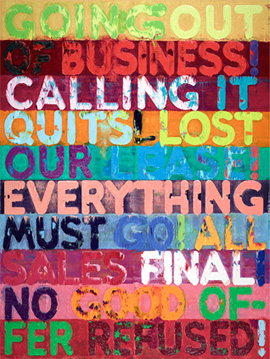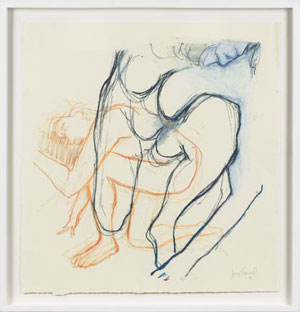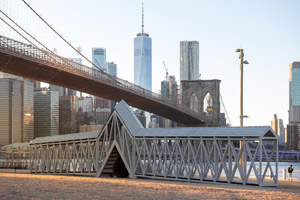Fair Versus Fair
John Haberin New York City
The 2019 New York Art Fairs I
Are the art fairs dying? Definitely not, but the competition keeps getting tougher.
They are turning on one another at that. As the Armory Show prepared to open, it took a hit from something worse than cold March winds off the Hudson River. New York declared much of its pier for modern art unsafe even compared to the risks of the art market. Conveniently enough, it moved that half of the action a pier south—obliging Volta New York to suspend operations. A powerhouse like the ADAA Art Show or the Armory Show could come on stronger than ever,  but that still leaves a tough question: who gets to speak for emerging art?
but that still leaves a tough question: who gets to speak for emerging art?
Who will speak for them?
Not that art fairs are going away any time soon. The Miami round had barely ended before the scene shifted to (goodness) LA, even as everyone involved planned for New York in early March. And Volta will surely be back in action in 2020, like it or not. Still, the pressure is on. Pulse and the Moving Image had already dropped out by last year—the latter's Tunnel warehouse space west of Chelsea giving way to retail expos and a bleak excuse for a food court. Now others, too, are struggling to survive.
NADA shut its doors, leaving only NADA House on Governors Island and a map of its mostly Lower East Side galleries with coordinated extra hours. (Who needs art fairs anyway?) ADAA released a map, too, but of the Upper East Side. Superfine! (not my exclamation point, alas) avoided inquiries until the very eve of the fairs, when it announced that it is holding off until May. Spring Break even turned its belated scrounging for space into a virtue. It divulged its new location on UN Plaza only days before the opening, like a private club daring anyone to feel like an insider.
It has sure upgraded its image since its origins in Soho, its dismal rooms and trashy installations in the old Farley Post Office building, and an office building in Times Square. Maybe it rather than Broadway north of Madison Square should be called NOMAD. Its new home in a condo in UN Plaza is its brightest yet, with a simple layout, at last clearly labeled booths, and a terrific view of the East River. Yet it is still scrounging, and so, thankfully, are its contributors. Speaking of art and money, C. J. Hendry contributes a human-size prescription drug container filled with pretend cash, as Drug Money. And speaking of rivalries, the show opens with a registration counter, where one can register as Us or Them.
Galleries know the competition all too well. They, too, are thriving, judging by sheer numbers—even as so many become fossils or adopt a "hybrid model" of private dealing and, sure enough, art fairs. They know as well how much the fairs add to the financial and logistical pressures on them. Are the fairs now no longer immune? The coexistence of competition, multiplicity, and big money could serve as a parable of globalism and cut-throat capitalism. The ADAA Art Show only adds to the risks by running the week before others, challenging collectors who pick just one weekend to drop in.
One could argue that the players are actually cooperating, much as Volta gave way gracefully, foregoing the income and refunding the costs to galleries. Scope and Art on Paper found space for a few, while others came hastily together in not fairs but pop-ups, assuming one can tell the difference. Thirty of them landed in the very heart of Chelsea's wealth, thanks to space from David Zwirner and Paula Cooper galleries, as Plan B. Greg Smith designed a line of life preservers for the occasion—although one might mistake them for a celebration of nationalism, populism, and the Yellow Vests. Still, the open layout, with no booths conceivable on such short notice, only emphasized the paltry offerings. Not even a visually striking wall of mosquito nets, by Tahir Carl Karmali with Alaina Simme, could take on a physical presence or its promised message about immigration.
One could argue, too, that fewer fairs are no great loss. I could live without most of them, and even Volta may have lost its reason for being. By now the ADAA and others have adopted its single-artist booths, and galleries worth watching have mostly gone elsewhere. Still, NADA has a clear profile, between the chaos of artist collectives and the wealthiest of class acts. Where does that leave midlevel galleries, on the edge of bankruptcy even before being reduced to "virtual exhibitions" and cautious reopenings after Covid-19, but also on the cutting edge of art? Who will speak for them?
Searching high and low
Not Spring Break, given its trust in artists and curators rather than dealers, but one could do far worse. "Suites" for "special projects" open onto a long, wide row of facing booths, like a single changing environment. It includes a bedroom, a playroom (with balloons and a birthday cake), an operating room, a conservatory, and a shooting gallery—targeting a bullet-ridden metal sign for Weapons of Mass Destruction. It has ample space for paintings, but also a gallery closed forever for installation.  Light seemingly from nowhere picks out slim threads crossing a dark room, for the perspectival planes of A Vertiginous House, by Aysha Hamouda. Art should always be so spatially alive and disorienting.
Light seemingly from nowhere picks out slim threads crossing a dark room, for the perspectival planes of A Vertiginous House, by Aysha Hamouda. Art should always be so spatially alive and disorienting.
Not Salon Zürcher, for its cast of five can go only so far. Besides, the Nolita gallery has drawn back from its aspirations to a fair. With mostly contributing artists, rather than a mix of New York and European dealers, it comes off as just another group show. The lone dealer apart from Zürcher itself, Chris Boïcos from Paris, displays Michael Goro's etchings and engravings of city streets, with a look somewhere between photography and fantasy. Anne Russinof calls three pairs of broad curves Three Wishes, and perhaps they are. Single brush marks in wet on wet merge with the equally brushy ground, enough to have me wishing for abstraction—but not, I am afraid, for another fair.
Not Art on Paper, given its obvious limits—and permit me to leave a fuller report to a second round, including shows of single media, later this spring. Not pop-ups or Clio, now in its second year in Chelsea, but still a glorified group show of mediocre painters. Certainly not Scope, given its ragtag assembly of artists and dealers, few from New York. It displays not emerging ideas, but one tired trope after another. It has the defacement of old masters and the cartoon imagery in painting and sculpture. It has the pixilated portraits and the glitter. It has the token interest in women, even as it condescends to actual elderly women as opposed to sainthood for Frida Kahlo.
Not the ADAA either, but for the very opposite reason. It stands splendidly apart even on the high end, without the hectic pace of the Armory Show or that fair's concessions to newcomers. The Art Show flaunts its wealth, in the comfort of the Park Avenue armory, but it also welcomes a closer look at what it means to play by the rules. Sperone Westwater snags a privileged spot by the opening, for a display of Susan Rothenberg, but almost without Rothenberg's horses. It features instead a woman's silhouette, dark masks, and skeleton. It signals that the entire fair will feature solo booths, women, and surprises.
It has so many women, in fact, that I can name only a few. They run from the calm of Marsha Cottrell with Anthony Meier, between Op Art and Minimalism, to the disorder of Judy Pfaff with Miles McEnery, Carolee Schneeman (who died just days later) with Galerie Lelong, and Carrie Moyer with D. C. Moore. They run, too, from an older art of a woman's exposed but monumental body, in Joan Semmel with Alexander Gray along with Betty Parsons, to Jordan Casteel in portrait mode with Casey Kaplan. Maira Kalman with Julie Saul riffs on the Autobiography of Alice B. Toklas, while Hirschl & Adler speaks simply of a "modern sisterhood." David Zwirner finds an unlikely pair in Diane Arbus and Alice Neel. Their similar subjects and compositions, would be downright spooky, even were Arbus not spooky enough on her own.
Not that the fair limits its discoveries to women. Michael Rosenfeld features Henry Tanner, an African American who studied with Thomas Eakins only to abandon a taut, crisp realism for echoes of Symbolism and Romanticism. Matthew Ritchie with James Cohan moves between blots and mappings, while Sam Moyer with Sean Kelley turns broken slabs into abstraction. Photos by Thomas Struth with Marian Goodman overlay landmark skylines with white, so that New York streets become nowhere land. Venus over Manhattan piles on boxes, including one by Andy Warhol—but not for Brillo. The most sedate of art fairs is stepping out of the box.
What art needs most
The Independent could make the edgiest of outsiders look established. Now in its tenth year, it embraces nonprofits and alternative spaces, like White Columns and SculptureCenter, along with mostly downtown and international dealers. One Tribeca gallery held its Friday opening just minutes away. It has "special projects" for Gretchen Bender, with a loud two-channel video of repeated explosions, and for Material Lust, a collective that turns paintings, walls, and furniture alike into a creepily palpable environment. It has such long-time rebels as Martha Rosler with Nagel Draxler and Bruce Connor with Anglim Gilbert—but also a "skybox" and split-level spaces, like a luxury condo. As if in response, Rosler combined her theme of "House Beautiful" with dreamy views of outer space.
Could that mix of aspirations, disruptions, and achievement be just what art needs most? It may flatter collectors and others to think so, but anyone who survives fair week deserves a little flattery now and then. One could chose between gentle transgressions, such as shrouds and distorted hand gestures by Renate Bertlmann with London's Richard Saltoun, and quietly pulsating abstraction—like wool and quartz on linen by Martha Tuttle with Tilton, sandpaper in near Cubist collage by Irwin Kremen with Klaus von Nichtssagend, or evanescent colors on gesso by Markus Amm with David Kordansky. Every so often one might miss the explosions, but then every so often, too, one might learn something. Jean Painlevé was making photography into abstraction in the 1930s with close studies of marine life, with Air de Paris, while Ceija Stijka recalls the horrors of the camps for herself as a Gypsy in those very same years, with Christophe Gaillard. It all went into what the United States Holocaust Memorial has called the Holocaust Encyclopedia. 
Could that leave the Armory Show itself to stick up for the future? It tries to reinvent itself for its twenty-fifth anniversary—even as it hastily replicates its layout over three piers. It may have little choice, between a faltering market at the high end and a faltering supply of the last century's classics. Last year it cut back its section for Modernism to half a pier, and now it seems to have little heart for such "insights." Just two years back, I asked what you can find at the fairs and answered "anything you like." So much for that.
One can still find works on paper by the likes of Richard Serra and Ellsworth Kelly and a decent large abstraction by Grace Hartigan, but not a deeper history. One might as well, then, look to the future. Most of the rest, though, sticks to business as usual in the present, as galleries trot out their wares. That makes lists of what you absolutely have to see, however much journalism thrives on them, irrelevant or impossible. Should you, like me, far prefer slowly shifting digital environments by Peter Campus, with Cristin Tierney, to Lego paintings of childish images by Ai Weiwei with Jeffrey Deitch? I shall, for once, be generous and call it a matter of taste.
That leaves three features of the Armory Show to beg for attention. Lauren Haynes curates the half a pier for "Focus," although its theme of "transitional spaces" is hard to pin down. Still, any theme show that can find similar colors, imagery, and activism in Faith Ringgold in Harlem (with ACA), Miriam Schapiro in "Pattern and Decoration" (with Firestone), and Arjan Martins in Rio (with A Gentil Carioca) cannot be half bad. Of the nine "Platform Projects," or large sculpture scattered throughout, some go to bulk and flash. Leo Villareal (with Pace) treats the night sky as a multi-channel light show, while Pascale Marthine Tayou (with Richard Taittinger) makes a threat to the environment downright welcoming by constructing a hot-air balloon from discarded plastic bags. Others, like Jessica Stockholder, play on frustrated thoughts of home with architectural models. For Siah Armajani (also in the Independent, but here with Rossi & Rossi), his Seven Rooms of Hospitality extend to a truck, a cage, a conference room, and a prison.
At the very back, one finally encounters emerging dealers, with booths at a discount devoted to a single artist. Still, welcome as they are, "Presents" presents if possible too international a cast for the future to come into focus or to assist those most in need of help. Who, then, will speak for a mainstream yet to come, and can fairs do more than line some pockets at the expense of others? Will they drive each other out of business if they try? The May fairs will offer still more competition and more alternatives. See you then.

These New York art fairs ran mostly March 7–10, 2019. Related reviews report on past years, next year, the AIPAD Photography Show, the May art fairs coming up, spring 2022 art fairs, fall 2022 art fairs, spring 2023 art fairs, and fall 2023 art fairs to come, Condo NY, claims for the death of art fairs after Covid-19, and a panel discussion of "Art Fairs: An Irresistible Force?" And do not forget the 2020 art fairs and 2021 art fairs to come.




